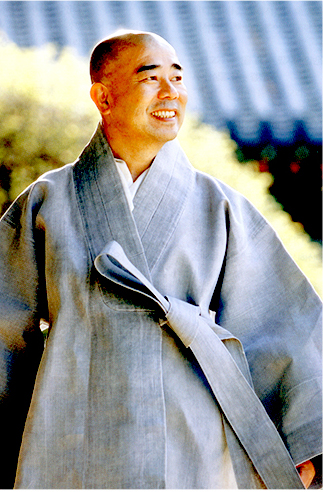
Welcome everybody who is interested in the true ascetic life in Buddhism and Korean traditional culture.
Korean Buddhism is one of the national religions that has represented and shared for more than 1700 years with Korean traditional culture. Woljeongsa Temple has represented Korean Buddhism since its foundation about 1400 years ago and has known for the sacred place of Manjusri until today.
Woljeongsa Temple in Odaesan Mountain is one of the most important temples in Korean Buddhism and many records were found in Samkukyoosa, the history book written by Master Il-yeon.
In Samkukyoosa, it says the place that Woljeongsa Temple was built is the only best place that makes Korean Buddhism flourished. Besides these, there is Jeokmyulbogung on the middle peak, called Joongdae, which holds the piece of skull of the Buddha. Sangwonsa Temple is also in Odaesan Mountain, which has the interesting story about King Sejo in Joseon Dynasty.
At that time King Sejo visited Sangwonsa Temple, he was suffering from a skin disease, and he took a bath in the stream in front of the temple.
A little boy washed his back and told him not to tell anybody that he met Manjusri and disappeared. After he met the little boy who was the present of Manjusri, the king got over his disease.
There are Mireakam and Younggamsa Temple also in Odaesan Mountain. Specially, in front of Younggamsa Temple, there is Sago (the archives building of Joseon Dynasty) and it held Annals of the Joseon Dynasty and Joseon royal protocols, which are UNESCO's Memory of the World Register.The natural environment around Woljeongsa Temple is also attractive and venerable.
Keumgangyeon in front of Woljeongsa Temple and Soojeongam on the west peak of Odaesan Mountain are the origins of Han River according to Annals of the Joseon Dynasty and Annals of King Sejong. Banyayeon is in the upper stream, in which a legend was heard that a dragon lived. At the foot of the stream, Samidae is situated boasting its beautiful scenery. From Iljoomun (the one pillar gate) through the second gate, Chunwangmun, there is a about 1km beautiful path through firs.
I hope everybody who visits Woljeongsa Temple can leave their daily life and relax for a moment. Aristotle told in his ‚ÄėNicomachean Ethics‚Äô, the true purpose of all life is being happy. The Buddha also clarified the purpose of his taught in Jeondoseoneon, as he said, it is ‚Äúfor happiness and comfort for all beings.‚ÄĚ Woljeongsa Temple is opened to everyone who seeks the happiness of life, so please come and get the comfort and peace for your heart and soul.
In Bubbodankyung, Master Yookjo Haenung said, ‚Äúa wise person get over thousands of fools like one dim light of lamp can take away the darkness of thousands of years‚ÄĚ. Please come Woljeongsa Temple and have the wisdom of Manjusri; and dispel all sufferings and agonies in life with that.
With mercy and happiness of the Buddha,
Jeongnyeom
Korean Buddhism is one of the national religions that has represented and shared for more than 1700 years with Korean traditional culture. Woljeongsa Temple has represented Korean Buddhism since its foundation about 1400 years ago and has known for the sacred place of Manjusri until today.
Woljeongsa Temple in Odaesan Mountain is one of the most important temples in Korean Buddhism and many records were found in Samkukyoosa, the history book written by Master Il-yeon.
In Samkukyoosa, it says the place that Woljeongsa Temple was built is the only best place that makes Korean Buddhism flourished. Besides these, there is Jeokmyulbogung on the middle peak, called Joongdae, which holds the piece of skull of the Buddha. Sangwonsa Temple is also in Odaesan Mountain, which has the interesting story about King Sejo in Joseon Dynasty.
At that time King Sejo visited Sangwonsa Temple, he was suffering from a skin disease, and he took a bath in the stream in front of the temple.
A little boy washed his back and told him not to tell anybody that he met Manjusri and disappeared. After he met the little boy who was the present of Manjusri, the king got over his disease.
There are Mireakam and Younggamsa Temple also in Odaesan Mountain. Specially, in front of Younggamsa Temple, there is Sago (the archives building of Joseon Dynasty) and it held Annals of the Joseon Dynasty and Joseon royal protocols, which are UNESCO's Memory of the World Register.The natural environment around Woljeongsa Temple is also attractive and venerable.
Keumgangyeon in front of Woljeongsa Temple and Soojeongam on the west peak of Odaesan Mountain are the origins of Han River according to Annals of the Joseon Dynasty and Annals of King Sejong. Banyayeon is in the upper stream, in which a legend was heard that a dragon lived. At the foot of the stream, Samidae is situated boasting its beautiful scenery. From Iljoomun (the one pillar gate) through the second gate, Chunwangmun, there is a about 1km beautiful path through firs.
I hope everybody who visits Woljeongsa Temple can leave their daily life and relax for a moment. Aristotle told in his ‚ÄėNicomachean Ethics‚Äô, the true purpose of all life is being happy. The Buddha also clarified the purpose of his taught in Jeondoseoneon, as he said, it is ‚Äúfor happiness and comfort for all beings.‚ÄĚ Woljeongsa Temple is opened to everyone who seeks the happiness of life, so please come and get the comfort and peace for your heart and soul.
In Bubbodankyung, Master Yookjo Haenung said, ‚Äúa wise person get over thousands of fools like one dim light of lamp can take away the darkness of thousands of years‚ÄĚ. Please come Woljeongsa Temple and have the wisdom of Manjusri; and dispel all sufferings and agonies in life with that.
With mercy and happiness of the Buddha,
Jeongnyeom

